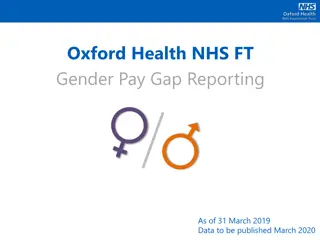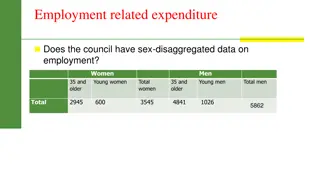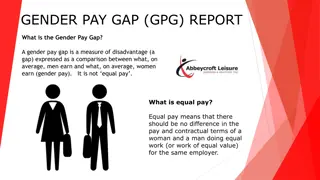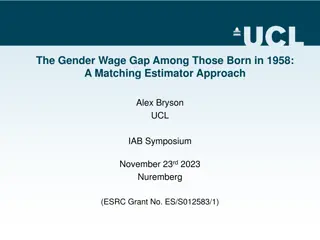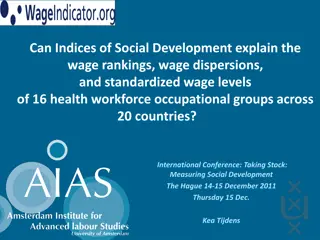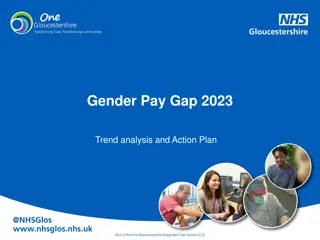Exploring Gender Wage Gap: Motherhood and Job Dynamics
The study by Aedín Doris, Dónal O’Neill, and Olive Sweetman from Maynooth University delves into the reasons behind the diverging earnings of male and female graduates. It highlights the impact of motherhood and job dynamics on the gender wage gap, shedding light on the disparities in earnings between men and women in the workforce.
Download Presentation

Please find below an Image/Link to download the presentation.
The content on the website is provided AS IS for your information and personal use only. It may not be sold, licensed, or shared on other websites without obtaining consent from the author. Download presentation by click this link. If you encounter any issues during the download, it is possible that the publisher has removed the file from their server.
E N D
Presentation Transcript
Why Do the Earnings of Male and Female Graduates Diverge? The Role of Motherhood and Job Dynamics Aed n Doris, D nal O Neill and Olive Sweetman Maynooth University Results are based on analysis of strictly controlled Research Microdata Files ( ELD and GUI) provided by the Central Statistics Office (CSO). The CSO does not take any responsibility for the views expressed or the outputs generated from this research.
Gender differences in earnings are particularly pronounced among top earners. There is evidence that this gap widens over the working career and is particularly pronounced for women with children. Background Some authors have found that gap widens more for some occupations/degrees.
We use rich administrative data covering earnings from 2010-2020 for a large sample of Irish graduates to examine gender differences in earnings dynamics and returns to a broad range of fields of study. Our paper We look for potential explanations for this gender gap, focusing on childbirth and job mobility. In addition we use a supplemental data set to look at changes in hours of work associated with childbirth.
The Educational Longitudinal Database (ELD) matches graduates across a range of pseudonymised administrative sources including education data earnings data and data on benefit receipt. Other background information includes type of school attended, local area deprivation statistics, Leaving Cert points, within school ranking, age and gender. Data Random sample
Gender Earnings Gap Following Graduation.
- Gender Earnings Gap grows over time. - Almost all of this gap arises within field of study.
Gender Earnings gap by Field of Study
Gender Earnings gap by Field of Study All Men v Women with Children.
Gender Earnings gap by Field of Study Men V Women with no children
Gender Earnings Gap Dynamics by broad field: Business & Law STEM Other 28% 23% 28%
Gender gap increases over time within field. This is particularly true for women with children. Summary This holds for all three broad field groups.
Earnings Change around childbirth - Mothers -23%,
Motherhood wage penalty: 27% Earnings Earnings Change Change around around childbirth childbirth Mothers and Mothers and Fathers Fathers
Differences in Mobility Hours of work What explains this gap?
Decompose Gender gap In Wage growth : Difference in earnings changes: i)for stayers (ii) for switchers. iii) difference in mobility rates. What explains this gap - Mobility? Mobility?
Decomposition Decomposition of the Gender of the Gender Difference in Difference in Wage Growth Wage Growth
Gender differences in earnings growth is almost entirely explained by the fact that men experience higher earnings gains than women, particularly as stayers ; Gender differences in mobility account for very little of the observed gap. What explains this gap - Mobility? Mobility?
Since we do not have hours in the ELD, we do a back of the envelope exercise to see the likely role of hours using a supplemental data set, the GUI infant cohort. What explains this gap Hours of Hours of work? work?
Restrict our sample to first- time mothers with higher education who were working prior to childbirth. What explains this gap Hours of Hours of work? work? The GUI infant cohort has information on work hours for both mothers and fathers in most waves but also asks mothers about their hours of work before their baby was born.
Hours of Work Hours of Work around around childbirth for childbirth for Mothers and Mothers and Fathers Fathers
Mothers hours of work fall from an average of 38 hours to 33 hours in the year after childbirth, a 13% reduction. What explains this gap Hours of Hours of work? work? Fathers worked on average 41 hours after childbirth.
13% fall in hours (GUI) 27% fall in weekly earnings (ELD) What explains this gap Hours of Hours of work? work? Suggests that about half of the fall in earnings is accounted for by a fall in hours.
Gender earnings gaps emerge early on in graduates careers. This occurs within field of study and after controlling for a range of other background factors Conclusion (1)
The gap is particularly apparent for women with children and coincides with childbirth. Conclusion (2) There is no striking differences between fields of study
Explanations Wage dynamics are driven by job stayers and not job mobility. Conclusion (3) Hours of work may contribute about half of the earnings reductions.
Reduction in Hours: Changes in work practices Conclusion (4) Re-allocation of time within household.
Substantial proportion not related to hours. May also need more research on personnel practices within firms following childbirth. Conclusion (5) Report gender gap in earnings changes for job stayers in the firm






